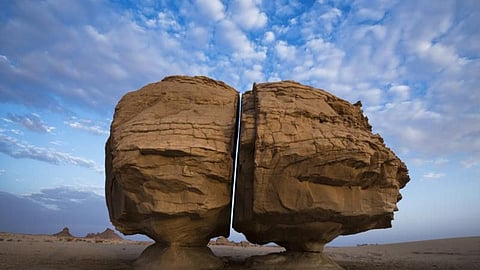Did aliens visit Saudi Arabia thousands of years ago?
Perfect split in Al Naslaa rock that baffled geologists, sparks a debate on social media

Also In This Package
Abu Dhabi: The Al Naslaa rock, south of Tayma in Saudi Arabia, has puzzled many scientists for years because of the accuracy of the large cut in the massive rock, which is 9 meters high and 7.6 meters wide.
The rock has sparked a debate on social media, with some saying aliens visited the kingdom thousands of years ago, and the accidental exposure of the rock to a space laser bombardment.
Some geologists argue that the split may be the result of weathering (melting ice), but others say the split is too subtle and smooth to be natural.
Geologist Cherry Lewis told MailOnline Travel the split could be man-made, or it might be caused by weathering and erosion
It’s a question that’s been thrown up by a mysterious gigantic rock there - that looks like it’s been cut in half by a laser beam.
Geologist Cherry Lewis says the smooth front surface of the rock formation may have been created by a ‘sandblasting effect’
Lewis, who is an honorary research fellow at the University of Bristol, describes the unusual formation as a ‘remarkable sight’. She says: “It [the split] could have formed due to a process called ‘freeze-thaw’ weathering, which occurs when water gets into a small crack in the rock. As temperatures drop, the water freezes and expands which causes the crack to widen and lengthen.”
Lewis says the “sandblasting effect could also have created the smooth front surface if that faces the prevailing wind.”
While weathering and erosion could be to blame, Lewis agrees there may be truth to the theory the rock was painstakingly sliced by humans. She says: “Given that past civilisations created Stone Henge and the sculptures on Easter Island with the most basic of tools, it doesn’t seem out of the question that it could be man-made.”
Her verdict? “On first appearance, the crack looks man-made, as does the very smooth front surface, but I see a photo that shows a parallel crack on the back, so it is possibly natural.”
Geologist and geophysicist Professor Tim Reston of the University of Birmingham says the split is “probably a joint, which is a natural fracture in the rock typically caused by pressure release and expansion, formed when the rock layer was more continuous, and now left exposed by erosion of the surroundings”.
Reston adds: “If [it is] a joint it might have beautiful ‘plumose’ structures on both sides of the crack - they look like feathers - unless these have been widened by wind erosion.”
The rock formation is an eight-hour drive from Riyadh, and it can be accessed by car. Rich in history, Tayma was the residence of the Babylonian king Nabonidus in the mid-6th century BC. The oasis, which featured on the trade route from modern-day Medina to Al Jawf, subsequently became a popular spot for traders.
Sign up for the Daily Briefing
Get the latest news and updates straight to your inbox









